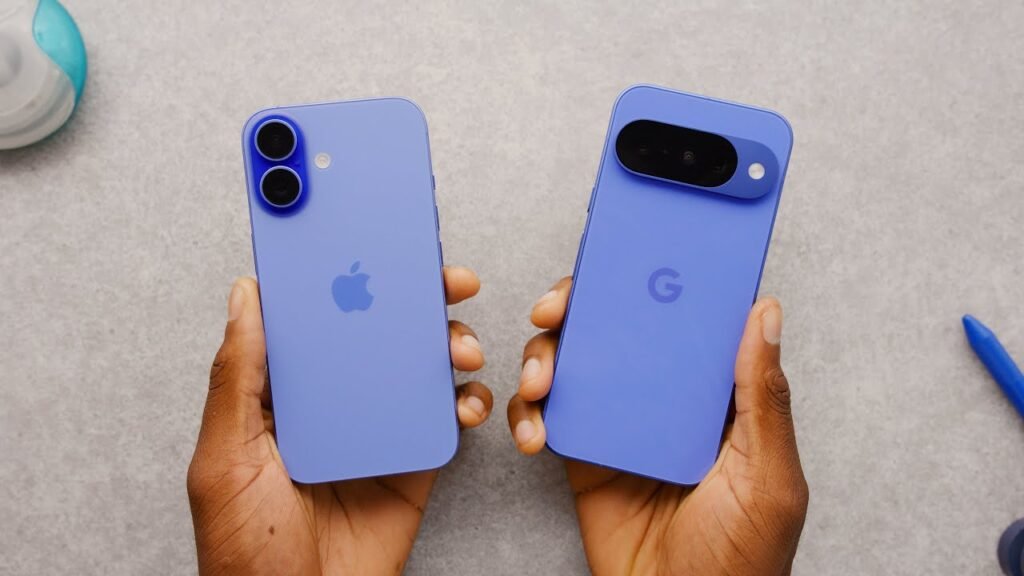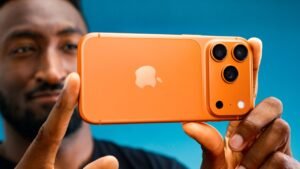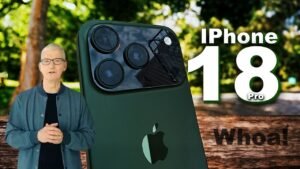Switching from iPhone to Android

Switching from iPhone to Android
Visitar canal: Marques Brownlee
In the ever-evolving world of smartphones, the debate between iPhone and Android is a hot topic among users. Many individuals consider switching from iPhone to Android for various reasons, including customization, hardware options, and pricing. This article aims to provide a comprehensive review of the process, benefits, and challenges of making this switch in 2025. By the end, you will have a clear understanding of whether transitioning to Android is the right choice for you, along with practical insights and tips to ease the process.
Switching from iPhone to Android: Is It Worth It in 2025?
Overview of Android Smartphones
What They Are and Who They Are For
Android smartphones are devices that run on the Android operating system, developed by Google. They are known for their flexibility, allowing users to customize their devices extensively. Android smartphones cater to a wide range of users, from tech enthusiasts who enjoy tinkering with settings to casual users looking for a straightforward experience. The variety of brands and models available means there is an Android phone for nearly everyone, whether you prioritize camera quality, gaming performance, or budget-friendliness.
Direct Competitors
The primary competitor to Android smartphones is the iPhone, which operates on Apple’s iOS. Other competitors include Windows phones, which have seen a decline in popularity, and various niche operating systems. However, Android holds a significant market share, with brands like Samsung, Google, OnePlus, and Xiaomi leading the charge. Each brand offers unique features, pricing, and ecosystems, making the choice between them crucial for potential switchers.
Technical Specifications
| Feature | Specification |
|---|---|
| Display | Varies by model; OLED or LCD options available |
| Processor | Qualcomm Snapdragon, Exynos, or MediaTek |
| Memory | 4GB to 16GB RAM depending on the model |
| Storage | 64GB to 1TB, expandable in many models |
| Battery | 3000mAh to 5000mAh, fast charging supported |
| Cameras/Sensors | Single to quad-camera setups, varying megapixels |
| Connectivity | 5G, Wi-Fi 6, Bluetooth 5.0 |
| System/Updates | Android 12 and above, with varying update policies |
| Average Price | $200 to $1200 depending on the brand and model |
| Warranty/Support | Varies by manufacturer, typically 1-year warranty |
Performance in Practice
Testing and Metrics
When switching from iPhone to Android, performance can vary significantly based on the model chosen. High-end models like the Samsung Galaxy S series or Google Pixel offer exceptional performance, with fast processors and ample RAM. Benchmarks often show that these devices can handle multitasking and demanding applications with ease. However, budget models may not perform as well, especially in gaming or heavy app usage. It’s essential to consider what you will use your phone for and choose a model that meets those needs.
User Experience
The user experience on Android can be quite different from that of iOS. Android allows for a high degree of customization, from changing launchers to modifying widgets on the home screen. This flexibility can be a double-edged sword; while it offers freedom, it may also lead to a steeper learning curve for those accustomed to the simplicity of iOS. Many users appreciate the ability to personalize their devices, but others may find the interface overwhelming. Transitioning users should take time to explore the settings and features available on their new Android device.
Pros and Cons
What Users Appreciate
- Customization: Android allows users to personalize their devices extensively, from themes to home screen layouts.
- Variety of Choices: Users can select from a wide range of devices across various price points.
- Expandable Storage: Many Android devices offer the option to expand storage with microSD cards.
- Integration with Google Services: Seamless integration with Google apps and services enhances productivity.
What Could Be Improved
- Software Updates: Android devices may not receive updates as quickly as iPhones, depending on the manufacturer.
- Fragmentation: The vast array of devices can lead to inconsistencies in performance and user experience.
- Learning Curve: Users switching from iPhone may find the transition challenging due to different operating systems.
Comparison with Competitors
Comparative Summary
When comparing Android to iPhone, several factors come into play. iPhones are known for their seamless ecosystem, consistent updates, and user-friendly interface. However, Android excels in customization, device variety, and price range. For instance, while an iPhone may offer a premium experience, an Android user can choose from budget to flagship devices that suit their needs. Additionally, while iPhones have a closed ecosystem, Android’s open nature allows for more flexibility in app choices and device modifications.
Who It’s For / Who It’s Not For
Ideal Profiles
Android smartphones are ideal for tech-savvy users who enjoy customizing their devices and exploring new features. They are also suitable for budget-conscious consumers who want a quality smartphone without breaking the bank. Furthermore, individuals who rely heavily on Google services will appreciate the seamless integration that Android offers. Gamers and photography enthusiasts will find high-performance Android devices that cater to their specific needs, making them an excellent choice for those looking for a powerful smartphone experience.
Who Should Avoid It
Users who prefer a straightforward, user-friendly experience may find Android’s customization options overwhelming. Those who are deeply integrated into the Apple ecosystem, using services like iCloud, iMessage, and Apple Music, might struggle with the transition. Additionally, individuals who prioritize timely software updates and security may prefer iPhones, as they tend to receive updates more consistently. If you value a cohesive user experience and are not interested in customizing your device, sticking with an iPhone may be the better choice.
FAQ
1. What are the main differences between iPhone and Android?
The primary differences between iPhone and Android lie in their operating systems, customization options, and ecosystems. iPhones run on iOS, which is known for its simplicity and seamless integration with other Apple products. In contrast, Android offers a more customizable experience, allowing users to modify their devices extensively. Additionally, Android devices come in a wider range of prices and specifications, catering to various user needs and budgets. Ultimately, the choice between the two depends on personal preferences and how users plan to utilize their devices.
2. Is it easy to switch from iPhone to Android?
Switching from iPhone to Android can be relatively straightforward, but it requires some preparation. Users should back up their data on the iPhone and familiarize themselves with the Android interface. Many Android devices come with tools to help transfer data from an iPhone, including contacts, photos, and apps. However, some apps may not have direct equivalents on Android, so users should check for alternatives. Overall, while there is a learning curve, many users find the transition manageable with the right resources and support.
3. Will I lose data when switching from iPhone to Android?
When switching from iPhone to Android, there is a potential risk of losing data if proper precautions are not taken. It is crucial to back up your iPhone data using iCloud or iTunes before initiating the switch. Most Android devices offer tools to facilitate data transfer, allowing users to move contacts, photos, and messages. However, certain apps and purchased content may not transfer directly, so users should check for alternatives or manually save important files. Taking these steps can help minimize data loss during the transition.
4. Can I use my iPhone apps on Android?
Unfortunately, iPhone apps are not directly compatible with Android devices due to differences in operating systems. However, many popular apps have Android versions available, allowing users to find equivalent applications. Users should check the Google Play Store for the apps they frequently use on their iPhones. In some cases, alternative apps may provide similar functionality, but the user experience may differ. It’s advisable to research and download necessary apps before switching to ensure a smooth transition.
5. How can I transfer my contacts from iPhone to Android?
Transferring contacts from iPhone to Android can be accomplished in several ways. One of the easiest methods is to use Google Contacts. First, sync your iPhone contacts with your iCloud account. Then, log into your Google account on a computer and import your iCloud contacts into Google Contacts. Alternatively, many Android devices come with a “Switch to Android” app that guides users through transferring contacts and other data directly. This process helps ensure that all important contacts are available on the new device.
6. Are Android devices more affordable than iPhones?
Generally, Android devices offer a broader range of pricing options compared to iPhones. While high-end Android smartphones can be as expensive as iPhones, there are numerous budget-friendly models available. Brands like Xiaomi, OnePlus, and Motorola provide quality smartphones at lower price points, catering to consumers looking for affordability. This variety allows users to find a device that meets their needs without overspending. In contrast, iPhones typically maintain a premium price point across their lineup, making them less accessible for budget-conscious buyers.
7. What should I consider before switching to Android?
Before switching to Android, consider your specific needs and preferences. Evaluate the type of features you value in a smartphone, such as camera quality, battery life, and customization options. Research different Android models to find one that fits your requirements and budget. Additionally, think about the apps you use regularly and whether they have Android equivalents. Familiarizing yourself with the Android ecosystem and understanding the differences from iOS will help ease the transition and enhance your overall experience.
Conclusion
Switching from iPhone to Android in 2025 can be a rewarding experience, offering greater customization and a wider range of device options. However, it’s essential to weigh the pros and cons carefully, considering your personal preferences and needs. By understanding the differences between the two ecosystems and preparing for the transition, you can make an informed decision. If you’re ready to explore the world of Android, take the plunge and discover the possibilities that await you. Start your journey today and embrace the freedom that comes with choosing an Android device!


